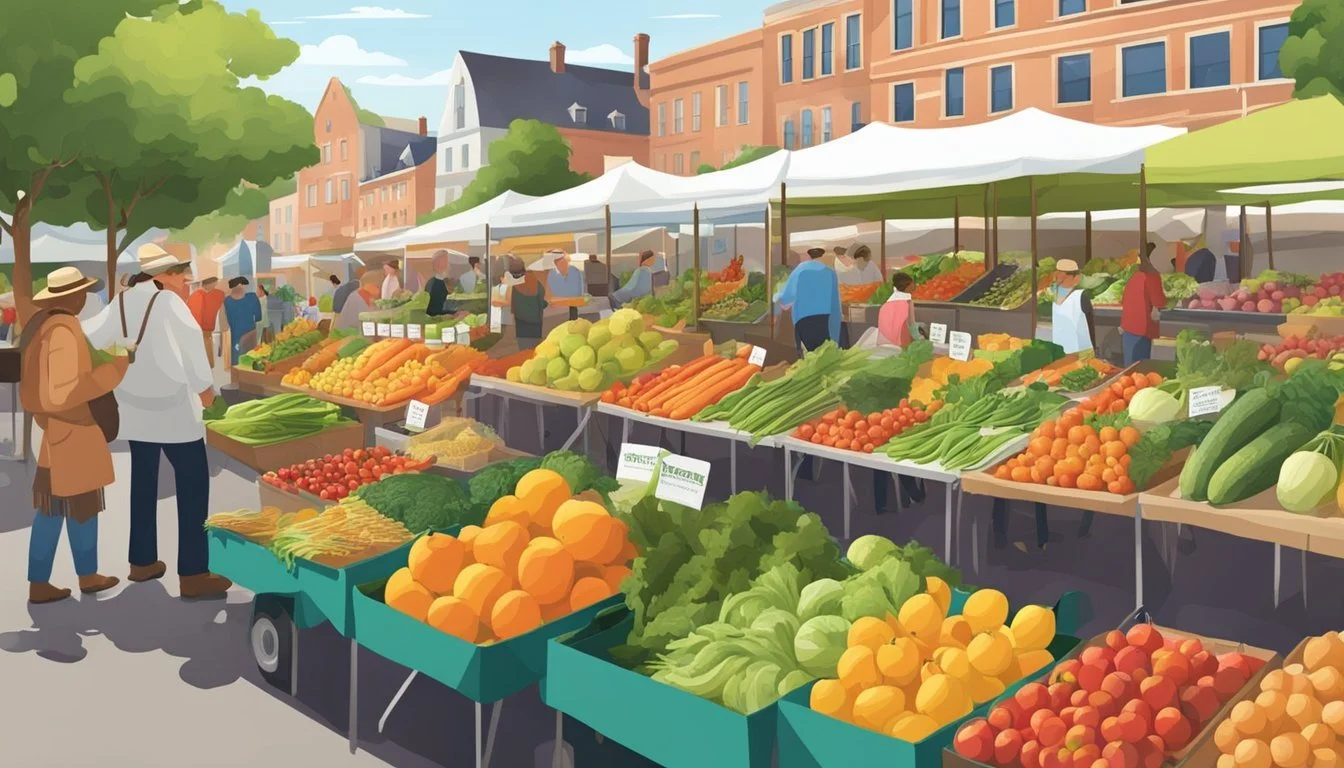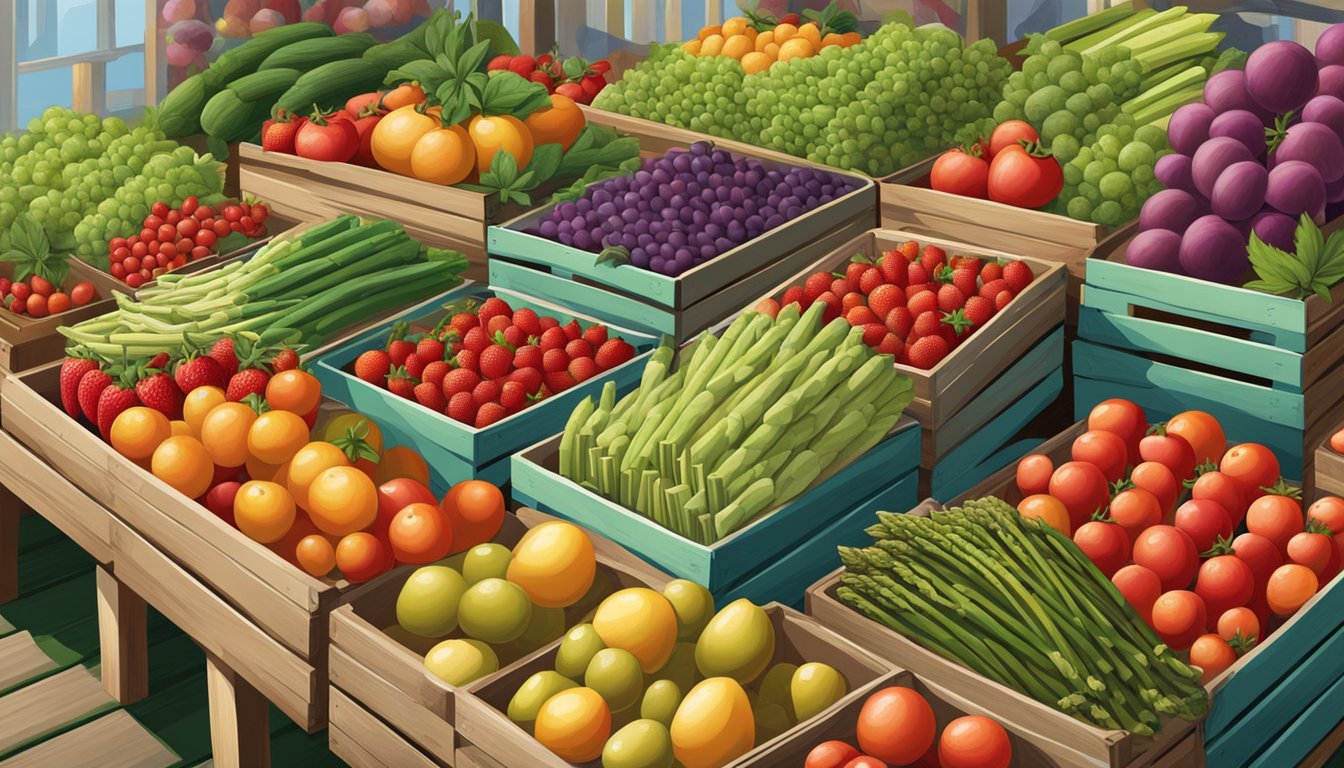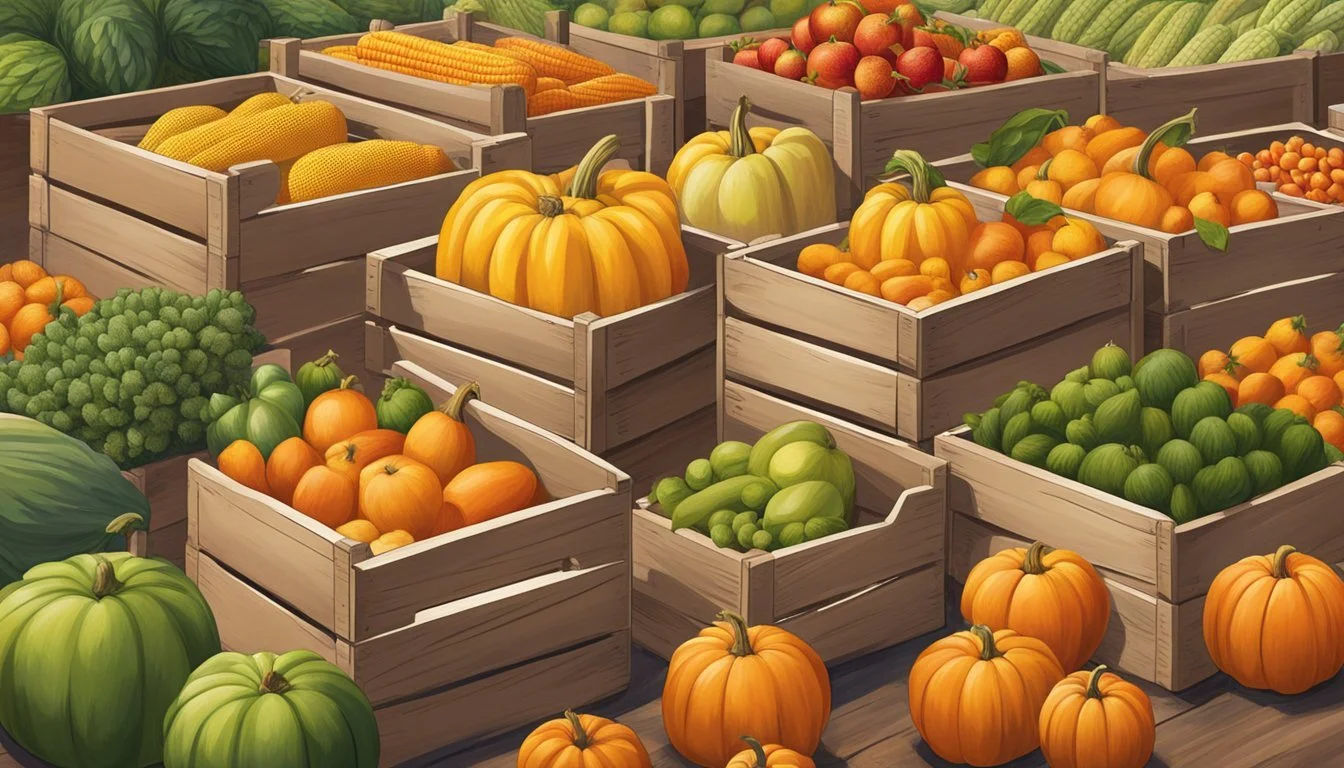Top 10 Must-Try Seasonal Produce at Your Local Farmers' Market
Fresh Picks Guide
A trip to the local farmers' market is a journey into the heart of agricultural freshness, where the connection between food and community comes to life. Seasonal produce offers not only peak flavors but also represents a more sustainable choice, benefiting both the environment and the local economy. By selecting fruits and vegetables at their seasonal peak, consumers enjoy a symphony of flavors while supporting local farmers who are stewards of the land.
The tapestry of colors and aromas that greet visitors is a testament to the variety and quality of fresh produce available from area growers. Such markets are an excellent source for discovering a cornucopia of local fruits and vegetables that are often harvested within a day of being offered for sale, ensuring a crispness and texture that supermarket equivalents may lack. Each visit to the farmers' market not only yields delicious ingredients for meals but also helps foster a sense of community and an appreciation for the cycle of nature.
Within this selection of fresh, seasonal produce lies the potential for culinary exploration. From the juiciest tomatoes to the sweetest corn, every item has a story that begins in the soil and ends on the plate. It celebrates biodiversity and encourages a diet that is in harmony with the local ecosystem. Engaging with the individuals behind the stands can provide insights into the best picks of the day, their farming practices, and cooking tips that enhance the eating experience.
Why Choose Seasonal Produce
Choosing seasonal produce at your local farmers' market offers multiple benefits ranging from health to flavor. Let's explore why consumers are opting for these timely harvests.
Health Benefits: Seasonal fruits and vegetables often contain higher nutrient levels. They are more likely to have been picked at their peak freshness, thereby retaining more vitamins and antioxidants. For example, seasonal pumpkins are rich in immune-boosting properties and contain compounds that promote healthy eyes and skin.
Freshness and Flavor: Produce that is in season is freshly harvested and has not endured long transportation or storage periods. This guarantees not only crispness and taste but also means that one is consuming products when their natural flavor is at its best.
Environmental Connection: Eating seasonally supports the natural agricultural cycle and is often linked with local farming. By purchasing from farmers' markets, one strengthens the connection to the environment and contributes to local ecology.
Support for Farmers: Buying in-season produce directly from local farmers ensures these hardworking individuals receive fair compensation for their crops. This encourages sustainable farming practices and helps maintain the agricultural community.
Diversity and Creativity: Seasonal eating naturally introduces a variety of fresh veggies and fruits into one's diet, sparking creative culinary ventures.
Here's a quick overview of the attributes of seasonal produce:
Attribute Benefit Nutrient-Rich Healthier diet Freshness Better flavor and texture Local Origin Supports community farms Diversity Encourages culinary variety
By selecting seasonal produce, one gains a fresher, tastier, and more nutritious diet while fostering a closer bond with the community and nature.
Spring Selections
As farmers' markets open in spring, they showcase an array of fresh produce. Shoppers can find an abundance of leafy greens, springtime fruits, and flavorful root vegetables. The following selections are prime picks to enjoy during the crisp beginnings of the year.
Leafy Greens and Herbs
Arugula and spinach make their tender appearance in the spring. Bursting with nutrients, these greens can be the base of a refreshing salad or a nutrient-packed smoothie. Kale also comes into season, offering versatility for dishes from salads to soups. Additionally, markets often feature a variety of fresh herbs like dill, which can elevate the flavors in any spring dish.
Arugula: Peppery, vibrant leaves ideal for salads.
Spinach: Soft, nutrient-rich leaves suited for raw and cooked dishes.
Kale: Hardy green perfect for sautés and chips.
Dill: Fragrant herb that complements fish and dressings.
Spring Fruits
Spring brings the sweetness of strawberries, a favorite for their juicy and flavorful profile. They stand out in desserts, salads, or simply eaten fresh.
Strawberries: Ruby red, sweet, and suitable for a variety of recipes.
Root Vegetables and Onions
Root vegetables like radishes offer a crisp, peppery kick to any spring meal. Green beans begin to make their way to the stands, ideal for side dishes or as a healthy snack. In the allium family, spring onions and garlic are at their peak, ready to enrich a multitude of recipes with their savory notes.
Radishes: Crunchy, with a spicy bite perfect for salads.
Green Beans: Tender pods that are great blanched, steamed, or stir-fried.
Onions: Pungent and sweet, an essential base for many dishes.
Garlic: A robust flavor enhancer for any savory food.
Every item listed not only serves as a fresh option but also represents the farm-to-table movement, encouraging healthy and sustainable eating habits.
Summer Harvest
The Summer Harvest period is marked by the emergence of sweet, juicy fruits and an array of vibrant vegetables. Local farmers' markets become bustling hubs where the season's best produce can be found, each boasting flavors that are best enjoyed at their peak of freshness.
Juicy Fruits and Berries
Peaches: Summer offers the peak season for peaches, with their fuzz-covered skin and juicy flesh that is both sweet and tangy. Opt for peaches that are slightly soft to the touch—they should have a fragrant aroma and a deeply-hued color.
Blueberries: These small, but mighty berries are at their best in summer. Look for plump, firm blueberries with a uniform deep blue color, which indicate maximum sweetness and a burst of antioxidants.
Summer Veggies
Tomatoes: Nothing compares to the taste of a sun-ripened tomato. They come in various sizes and colors, each variety offering a different balance of sweetness and acidity.
Vegetable Description Zucchini (What wine goes well with zucchini?) A versatile summer squash that is tender and mild in flavor. It's perfect for grilling, sautéing, or baking. Corn Fresh corn is sweet and crisp, with kernels that pop with flavor. Cucumber Refreshing and crisp, cucumbers are a staple in summer salads. Beans Green beans are at their peak, displaying a vibrant color and a satisfying snap when bent.
Bell Pepper: Available in a spectrum of colors, bell peppers are sweet, especially when they ripen to red, orange, or yellow.
Broccoli: For a hit of green, look for firm broccoli florets; it's delicious both raw and cooked.
Fresh Herbs
Chives: These delicate onion-flavored herbs add a subtle, fresh layer to any summer dish.
Basil: With its signature aroma and sweet-spicy flavor, basil leaves are a must-have for elevating summer meals, from salads to pasta sauces. Choose leaves that are bright green and free from spots or wilting.
Autumn Offerings
The Autumn season brings an abundance of produce to local farmers' markets. Shoppers can find a variety of hearty vegetables and late summer fruits to enhance their fall cuisine.
Hearty Vegetables
In the fall, squash and pumpkins stand out as the iconic vegetables of the season. Squash comes in various types, such as butternut, acorn, and spaghetti, each offering a unique flavor and texture. Butternut squash is versatile and can be roasted, pureed, or used in soups. Pumpkins, rich in dietary fiber and beta-carotene, are not just for carving. Their sweet flesh is perfect for pies and soups, and their seeds can be roasted for a healthy snack.
Mushrooms are another fall favorite, with their earthy flavor peaking during the cooler months. Local farmers' markets often feature a variety of mushrooms, from cremini to more exotic types like shiitake or oyster, which can elevate any dish.
Late Summer Fruits
While often associated with summer, apples continue to be prime produce into the autumn. The cooler weather allows for a crisper texture and sweeter taste. Shoppers can find a range of apple varieties, each suited for different culinary uses — from baking to snacking.
Farmers' markets may also offer late-harvest fruits such as plums or pears, providing a sweet balance to the earthy flavors (What wine goes well with earthy flavors?) of autumnal vegetables. These fruits are a great addition to any fall plate, whether eaten fresh or used in seasonal desserts.
Winter Goodness
During the colder months, farmers' markets still bustle with the earthy bounty of root vegetables and the robust flavors of winter greens. Patrons can discover an array of nutrient-rich produce that thrives in the winter climate.
Roots and Tubers
Farmers' markets teem with a variety of root vegetables that offer both a hearty texture and deep flavors. They are not only versatile in cooking but also packed with vitamins and minerals essential during winter.
Potatoes: These staples come in various types, including Russets and Yukon Golds. Potatoes are rich in vitamin C and potassium, making them an excellent choice for winter stews and casseroles.
Carrots: Carrots add sweetness and color to winter dishes. They are high in beta-carotene, which the body converts into vitamin A, vital for good vision and immune function.
Winter Greens
The winter season is not devoid of greens; in fact, certain leafy vegetables reach their peak during the chill.
Kale: Known for its durability in colder weather, kale offers a slightly bitter flavor with earthy undertones. It's a nutritional powerhouse, providing more than a day's worth of vitamins A, C, and K per serving.
Spinach: Spinach is a tender green that's ideal for a quick sauté or as a fresh salad base. Packed with iron and magnesium, it's as healthy as it is versatile.
These winter wonders not only survive but thrive in the colder months, bringing warmth and nutrition to any winter table.
Recipe Inspiration
When visiting a local farmers' market, customers can create vibrant and nutritious meals tailored to the season's best offerings. From crisp salads to hearty main dishes and delightful desserts, these recipes spotlight the freshest ingredients.
Salads and Sides
Farmers' Market Pasta Salad: A colorful blend of al dente pasta, cherry tomatoes, and seasonal vegetables, tossed in a light vinaigrette.
Stuffed Zucchini Boats: Zucchini halves filled with a mix of cheeses, herbs, and breadcrumbs, baked until golden.
Main Courses
Zucchini Lasagna: Slices of zucchini replace traditional noodles for a lighter, yet robust layered dish with ricotta, mozzarella, and marinara sauce.
Ratatouille (What wine goes well with ratatouille?): A classic French stew made with eggplant, zucchini, bell peppers, and ripe tomatoes, simmered to perfection.
Desserts and Snacks
Cherry Tomato and Mushroom Chicken: Saucy and flavorful, featuring fresh cherry tomatoes paired with mushrooms and garlic, perfect for a comforting dinner.
Vegan Butternut Squash Mac and Cheese: A creamy and satisfying side that creatively uses seasonal squash for a dairy-free twist on classic mac and cheese.
Tips for Shopping at Farmers' Markets
When visiting farmers' markets, shoppers should carry cash as most vendors typically operate on a cash-only basis. To expedite transactions, it's beneficial to bring smaller denominations such as ones and fives, facilitating easier exchanges for both the customer and the seller.
Patrons are encouraged to buy in bulk when while considering their needs and storage capabilities, as farmers often offer opportunities for larger quantity purchases. Buying in bulk can be efficient for events, or for preserving seasonal items.
When surveying produce, start with delicate items such as salad greens, berries, and baked goods. The heavier and more durable veggies and products, such as watermelons and squashes, can be collected towards the end of the market trip, preventing damage to the more fragile goods.
One should always:
Inspect produce closely; ensure it is fresh and of high quality.
Ask questions; farmers usually possess extensive knowledge about their offerings.
Be ready to adapt; while a shopping list is useful, flexibility leads to the best purchases which are based on what is freshest that day.
Finally, shoppers must stick to a budget, preventing overspending while still supporting local agriculture. Setting aside a specific amount for the market visit helps maintain financial discipline.
By keeping these tips in mind, visitors to farmers' markets can enjoy a successful and bountiful shopping experience.
Storing and Preserving Fresh Produce
When visiting a local farmers' market, consumers are often delighted by the range of fresh produce available. To maximize freshness and lifespan, preserving fruits and vegetables is essential. Refrigeration is key for many items but not all. The ideal fridge temperature should be at or below 40 degrees Fahrenheit, with 35-38 degrees being optimal for produce.
For vegetables, humidity control is important. Some refrigerators feature humidity drawers, which can be adjusted according to what's being stored:
High humidity: best for leafy greens, broccoli, and carrots.
Low humidity: suited for mushrooms, peppers, and ripe avocados.
Dehydrating is a superb method for preserving. It is particularly effective for fruits like apples, bananas, and berries. Dehydrated produce can be used as snacks or rehydrated for use in cooking and baking.
Preservation Method Suitable For Refrigeration Most fruits & veggies Dehydration Apples, bananas, berries
In terms of freezing, many fruits and vegetables freeze well. For example:
Blanching first allows vegetables like green beans and brussels sprouts to retain color and texture when frozen.
Freezing berries on a baking sheet before bagging helps maintain individual integrity.
Lastly, some produce such as onions and garlic should not be refrigerated but stored in a cool, dark place. They require good air circulation and should be kept separate from each other to prevent over-ripening. Fruits often produce ethylene gas, which can accelerate ripening in vegetables, so it's prudent to store them separately when possible.
Supporting Local and Sustainable Agriculture
When consumers purchase from their local farmers' markets, they play a crucial role in sustaining community agriculture. Local markets allow farmers to sell produce directly to the consumer, reducing the need for long-distance transportation. This practice not only cuts down on carbon emissions but also ensures fresh produce which is often picked within the peak of its ripeness.
Key Benefits of Shopping Local:
Freshness: Produce typically travels a mere fraction of the distance compared to supermarket goods.
Sustainability: Direct consumer-to-farmer transactions support sustainable farming practices.
Economic Support: Money spent on local produce circulates within the community, bolstering the local economy.
Personal Connection: Consumers often have the chance to meet and form relationships with the people who grow their food.
Farmers who participate in local markets also contribute to a smaller ecological footprint. They often employ organic or near-organic techniques, reducing the reliance on chemical fertilizers and pesticides which benefits the environment.
List of Sustainable Practices Noticed in Local Agriculture:
Use of natural pest control
Crop rotation
Conservation tillage
Community Impact:
Community Aspect Impact of Local Agriculture Economic Growth Revenue remains within the local economy Health Access to nutrient-rich, fresh produce Education Increased awareness of agricultural practices
Consumers support these sustainable efforts each time they choose local produce over imported goods. This decision fosters a healthier community and a robust local agricultural sector.










